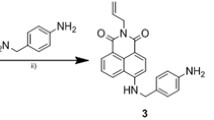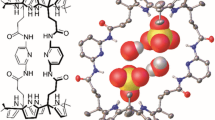Abstract
Three new selective anion receptors containing the (thio)urea binding sites were developed, Indole-3-formaldehyde phenyl-semithiocarbazone, Indole-3-formaldehyde nitrophenyl-semithiocarbazone, and Indole-3-formaldehyde nitrophenyl-semicarbazone, nominated as receptors 1, 2 and 3, respectively. Receptor 1 shows high selective recognition for F− only, while both receptor 2 and receptor 3 containing a p-nitro group show high selective recognition for AcO−. The high selective recognition of these receptors to anions is further investigated by X-ray crystallography diffraction, UV-vis, fluorescence analyses and 1H NMR. Furthermore, receptor 2 changes from yellow to orange, and receptor 3 darkens when acetate is added, providing a way of detection by ‘naked-eye’.









Similar content being viewed by others
References
Gunnlaugsson T, Glynn M, Tocci GM, Kruger PE, Pfeffer FM (2006) Coord Chem Rev 250:3094–3117
Gale PA, Garcia-Garrido SE, Garric J (2008) Chem Soc Rev 37:151–190
Dreisbuch RH (1980) Handbook of poisoning. Lange Medical Publishers, Los Altos
Gunnlaugsson T, Davis AP, O’Brien JE, Glynn M (2002) Org Lett 4:2449–2452
Schumacher AL, Hill JP, Ariga K, D’Souza F (2007) Electrochem Commun 9:2751–2754
Jose DA, Kumar DK, Kar P, Verma S, Ghosh A, Ganguly B, Ghosh HN, Das A (2014) Tetrahedron 63(2007):12007–12014
Moon KS, Singh N, Lee GW, Jang DO (2007) Tetrahedron 63:9106–9111
Joo TY, Singh N, Lee GW, Jang DO (2007) Tetrahedron Lett 48:8846–8850
Zhang YH, Yin ZM, He JQ, Cheng JP (2007) Tetrahedron Lett 48:6039–6043
Maeda H, Ito Y (2006) Inorg Chem 45:8205–8210
Shao J, Wang YH, Lin H, Li JW, Lin HK (2008) Sens Actuator B 134:849–853
Priyadip D, Prasenjit M, Amrita G, Amal KM, Tanmayanerjee B, Sukdeb S, Amitava D (2011) J Chem Sci 123:175–186
Martinez-Manez R, Sancenon F (2003) Chem Rev 103:4419–4476
Martinez-Manez R, Sancenon F (2006) Coord Chem Rev 250:3081–3093
Shao J, Lin H, Yu M, Lin HK (2008) Talanta 75:551–555
Shao J, Lin H, Shang XF, Chen HM, Lin HK, Inclusion Phenom J (2007) Mol Recognit Chem 59:371–375
Gunnlaugsson T, Davis AP, Glynn M (2001) Chem Commun 2556–2557
Gunnlaugsson T, Kruger PE, Lee TC, Parkesh R, Pfeffer FM, Hussey GM (2003) Tetrahedron Lett 44:6575–6578
Han F, Bao YH, Yan YH, Fyles TM, Hao JZ, Peng XJ, Fan JL, Wu YK, Sun SG (2007) Chem Eur J 13:2880–2892
Lee DH, Im JH, Lee JH, Hong JI (2002) Tetrahedron Lett 43:9637–9640
Watanabe S, Onogawa O, Komatsu Y, Yoshida K (1998) J Am Chem Soc 120:229–230
Liu Y, You CC, Zhang HY (2001) Supramolecular chemistry. Nankai University Press, Tianjin, pp 453–455
Huang WW, Lin H, Cai ZS, Lin HK (2010) Talanta 81:967–971
Acknowledgments
This project was supported by the National Natural Science Foundation of China (20371028, 20671052).
Author information
Authors and Affiliations
Corresponding author
Electronic supplementary material
Below is the link to the electronic supplementary material.
ESM 1
(DOC 157 kb)
Rights and permissions
About this article
Cite this article
Huang, W., Yang, Z., Lin, H. et al. Study on the Selectivity of Anion Receptors Based on Similar (thio)urea Fragments. J Fluoresc 23, 21–29 (2013). https://doi.org/10.1007/s10895-012-1110-9
Received:
Accepted:
Published:
Issue Date:
DOI: https://doi.org/10.1007/s10895-012-1110-9




